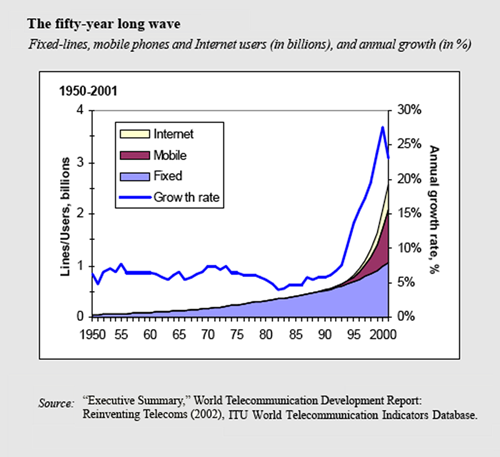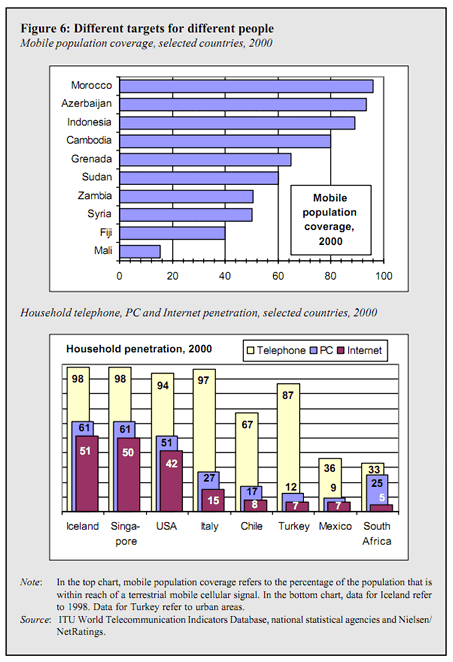CHAPTER 1: Context: Globalization and Technology Diffusion
As we look at and listen to the literacy narratives of Gorjana, Mirza, Tessa, and Kate; view the literate activity and writing process videos of Synne, Shafinaz, Sophie, Yu-Kyung, Vanessa, and Ismael; and read the literacy narratives of Dipo and Pengfei, we note that for most of their lives, the participants have known little of a world devoid of communication networks—linked telephone and computer systems, fax and telex connections, cell phones and text messaging—and rapid technological change. Even for the eldest among them, the innovations of personal computers, large-scale computer networks, and cell-phone technologies, along with the increasing levels of migration and international travel, have been part of their lives since they were teenagers or younger. In the midst of a 50-year period of rapid worldwide diffusion that fueled the engine of multinational capitalism and globalization, they moved across the globe, in some cases with parents because of war (Gorjana and Mirza) or a father’s career path (Shafinaz, Yu-Kyung), and in other cases without their parents in an effort to improve their opportunities for education (Sophie, Vanessa, Ismael, Dipo, and Pengfei).
The International Telecommunication Union (ITU, 2002, p.19) table below represents a 50-year period of growth in communication technologies throughout the world, during which the participants have lived.

During their early childhood, the rate of change that such technologies helped generate around the world only continued to accelerate. In 1983, the year Gorjana was born, the first cellular systems became commercially available (Oehmke, 2000) and the Minitel system had been deployed across France (Kessler, 1995), leaving French citizens poised to use the system to check telephone directories, make plane reservations, and chat. The ITU (2002, p. 9) table below shows the exponential growth of mobile phone usage during the 1990s and early 2000s.

Mobile telephones also became increasingly common in the developing world, and by 2000, just two years before Sophie left Bandung, Indonesia, for graduate work in the United States, mobile phone diffusion was 80% or greater in countries such as Morocco, Azerbaijan, Cambodia, and her native Indonesia. The ITU (2002, p. 21) tables below show mobile population coverage for select countries and household penetration in 2000.

In addition, mobile telephones began to be used for far more than voice communications, and by 2001 text messaging (short message service, or SMS) had become increasingly popular, more than doubling from 2000 to 2001 (see, ITU, 2002, p. 9).
In 2006, the ITU noted that countries such as India, China, Russia, Peru, Indonesia, Brazil, Poland, Japan, and Venezuela were among the top “gainers” on their Digital Opportunity Index from 2001 to 2005 (p. 10)
During these years, Vanessa had already traveled from Lima, Peru, for graduate work in economics at Georgetown University in Santiago, Chile, and Ismael was back in the United States from Puebla, Mexico, having spent his last high school year, 1998, at the University of New Mexico in a study-abroad program. Gorjana and Mirza were solidly settled in Australia and enrolled in schools in Sydney, where their parents had found work after migrating from the former Federal Republic of Yugoslavia (Bosnia-Herzegovina had been formally independent since 1992). Tessa and Kate had completed their Australian gap years abroad; Synne was a graduate student and digital media researcher working on her dissertation at the University of Oslo, Norway; Shafinaz, Sophie, Yu-Kyung, and Vanessa were enrolled in graduate programs at the University of Illinois, Urbana-Champaign; and Dipo and Pengfei were at Michigan Technological University in Houghton, Michigan, where Dipo was an undergraduate in Electrical Engineering and Pengfei was about to receive a Ph.D. in Biological Sciences. New developments in information and communication technologies (ICTs) during this first decade of the 21st century enabled many of them to keep in touch with family, colleagues, and friends from around the globe, as well as acquaintances they had met only online, with an ease and speed that had been impossible prior to this time.
previous < > CHAPTER 1: Global Ecologies and the Modern Internet
















